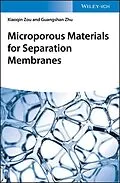A guide to membrane separation based on a variety of porous materials with promising separation applications
Microporous Materials for Separation Membranes offers an in-depth guide that explores microporous materials? potential for membrane applications. The authors?two experts on the topic?examine a wide range of porous materials that have application potential including: microporous silica, porous carbons, zeolites, metal-organic frameworks (MOFs), and porous organic frameworks (POFs).
Comprehensive in scope, the book covers a broad range of topics on membrane separations such as: hydrogen recovery, carbon dioxide capture, air purification, hydrocarbon separation, pervaporation, and water treatment. In addition, this up-to-date resource explores the most recent materials for preparing microporous membranes and explores the most promising applications for industrial use. This important book:
-Examines the use of microporous materials as membranes to perform with different gases and liquids
-Offers an overview of the basic knowledge of membrane separation and an intense examination of separations
-Describes the state-of-the-art of membrane separation with porous materials
-Highlights the most promising applications of industrial interest
Written for scientists working in the fields of membranes, gas and liquid, Microporous Materials for Separation Membranes offers a valuable guide to the potential of microporous materials for membrane applications.
Autorentext
Xiaoqin Zou, PhD., is a full professor at the Northeast Normal University (NENU) in Changchun, China. His current scientific interests include the syntheses, characterizations, and advanced applications of novel porous membranes.
Guangshan Zhu is the Director of Key Lab of Polyoxometalate Science of Ministry of Education at NENU, China. He has received numerous scientific awards, including the Second Grade Award of the State Natural Science Award of China, and more.
Inhalt
Preface xi
1 Introduction of Microporous Membranes 1
1.1 Introduction 1
1.2 Historical Development of Membranes 1
1.3 Microporous Materials 4
1.3.1 Carbonaceous Materials 4
1.3.1.1 Activated Carbon 5
1.3.1.2 Carbon Nanotubes 8
1.3.1.3 Graphene 11
1.3.2 Microporous Silica 14
1.3.3 Zeolites 16
1.3.4 MetalOrganic Frameworks 19
1.3.5 Highly Porous Polymers 21
1.3.5.1 High Free Volume Polymers 21
1.3.5.2 Porous Organic Frameworks 23
1.4 Fundamentals of Membrane Separation 27
1.4.1 Membrane Definition 27
1.4.2 Transport Theory 27
1.4.2.1 Membrane Transport for Gas Systems 27
1.4.2.2 Membrane Transport for Liquid Systems 29
1.4.2.3 Transport Mechanism in ED Membrane 32
1.5 Membrane Configurations 35
1.5.1 Membrane Structures 35
1.5.2 Preparation Techniques 36
1.5.2.1 Solution Casting 36
1.5.2.2 Melt Extrusion 36
1.5.2.3 Spinning 37
1.5.2.4 Spin Coating 37
1.5.2.5 Slip Coating Sintering 37
1.5.2.6 SolGel Technique 37
1.5.2.7 Carbonization 38
1.5.3 Membrane Technology 38
1.5.4 Membrane Modules 40
1.5.4.1 Plate-and-Frame Module 41
1.5.4.2 Tubular Membrane Module 41
1.5.4.3 Spiral Wound Module 41
1.5.4.4 Hollow Fiber Module 42
1.6 Features of Microporous Membranes 43
1.7 Conclusions 45
References 45
2 Microporous Silica Membranes 53
2.1 Introduction 53
2.2 Membrane Synthesis 53
2.2.1 SolGel Synthesis Method 54
2.2.2 Templating Approach 55
2.2.3 Chemical Vapor Deposition 56
2.3 Intermediate Layers 57
2.4 Support 58
2.5 Modification of Silica Membranes 58
2.6 Microporous Silica Membranes for Hydrogen Separation 60
2.7 Microporous Silica Membranes for Carbon Dioxide Separation 63
2.8 Microporous Silica-Based Membranes for Pervaporation Process 66
2.9 Microporous Silica-Based Membranes for Desalination 69
2.10 Conclusions and Future Trends 72
References 73
3 Carbon-Based Membranes 77
3.1 Introduction 77
3.2 Carbon Membrane Preparations 78
3.2.1 Carbon Molecular Sieve Membranes 78
3.2.1.1 Precursors of Carbon Molecular Sieves 79
3.2.1.2 Pyrolysis Environment for CMS Membranes 80
3.2.1.3 Pretreatments of CMS Membranes 81
3.2.1.4 Posttreatment of CMS Membranes 81
3.2.2 Module Construction of Carbon Membranes 82
3.3 Selective Surface Flow Membranes 84
3.4 Advantages and Disadvantages of Carbon Membranes 86
3.4.1 Advantages of Carbon Membrane Versus Conventional Polymer Membrane 86
3.4.2 Disadvantages of Carbon Membranes 87
3.5 Carbon Nanotubes 87
3.5.1 Types of CNT Membranes 87
3.5.2 CNT Functionalization 90
3.6 Porous Graphene 92
3.7 Carbon-Based Mixed Matrix Membranes (MMMs) 99
3.8 New Advances and Challenging Aspects 102
3.8.1 Concentration Polarization 103
3.8.2 Fouling 104
3.8.3 Mechanical Stability 105
3.8.4 Scalability 106
3.8.5 Cost 106
3.9 Conclusions 107
References 107
4 Microporous Membranes for Water Purification 115
4.1 Introduction 115
4.2 Types and State-of-the-Art Microporous Membranes in Water Purification 116
4.3 Removal of Water Contaminants (Inorganics, Organics, Biological) 118
4.3.1 Inorganic Pollutants 118
4.3.2 Organic Pollutants 124
4.3.3 Biological Pollutants 131
4.4 Membrane Desalination 134
4.5 Membrane Surface Engineering 144
4.5.1 Membrane Surface Engineering Using Nanoparticles 147
...